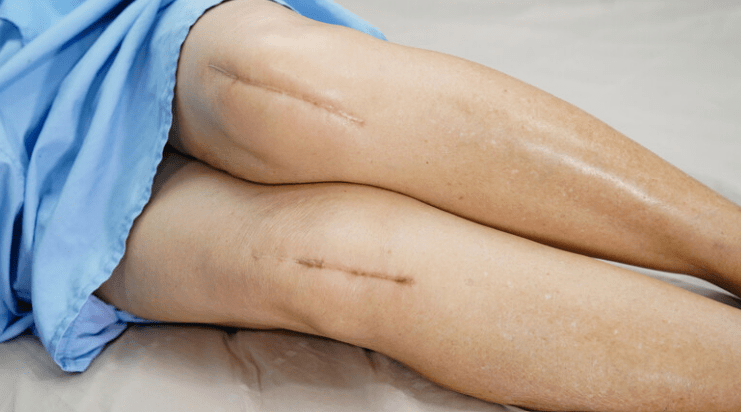Top 5 Mistakes after Knee Replacement– Knee replacement is a significant surgical procedure that could change your life for the better. Whether you’ve had a total or partial knee replacement, it’s important to note that the procedure comes with risks and challenges you should prepare yourself for, particularly during the recovery phase. After a knee replacement surgery, you’re likely to experience pain, swelling, and limited mobility. However, with proper care and adherence to your doctor’s instructions, you can optimize your chances for a fast and smooth recovery.
In this blog, we’ll highlight some of the most common mistakes patients make after knee replacement surgery and explore ways to avoid them.
Top 5 Mistakes after knee replacement Surgery

Mistake 1: Underestimating the Recovery Time
Patients undergoing knee replacement surgery typically require 3-6 months of recovery before they can resume their normal activities. Unfortunately, some people make the mistake of assuming that they’ll be back to their usual routines within weeks of the surgery. This approach to recovery could be counterproductive, as it could lead to setbacks, further injuries, and prolonged recovery. To avoid this mistake, it’s important to set realistic expectations, work closely with your doctor on a recovery plan, and engage in activities that are within your physical capabilities.
Mistake 2: Skipping Physical Therapy Sessions
Physical therapy is an essential part of the recovery process after knee replacement surgery. A physical therapist can help you regain your strength, flexibility, and range of motion, and prevent future complications such as blood clots and infections. Some patients make the mistake of skipping or neglecting their physical therapy sessions, thinking that they’ll be just fine without them. However, this approach could lead to a slower recovery, persistent pain, and a higher risk of complications. To avoid this mistake, make sure you attend all your physical therapy sessions and follow the exercises recommended by your therapist.
Mistake 3: Overdoing it or Not Doing Enough
Finding the right balance between resting and being active after knee replacement surgery can be challenging. Some patients make the mistake of overdoing it by engaging in demanding activities too soon or too frequently, while others may avoid exercise altogether. Overdoing it could lead to further injuries, while not exercising enough could lead to a longer recovery and loss of muscle mass. To strike a balance, work with your physical therapist and doctor to determine the right amount and intensity of activities that are suitable for your recovery stage.
Mistake 4: Ignoring Signs of Infection or Complications
Knee replacement surgery comes with some risks, including infections, blood clots, and nerve damage, among others. Some patients may make the mistake of ignoring the warning signs of these complications, thinking that they’ll go away on their own. However, this mistake could lead to further damage and prolonged recovery. To avoid this mistake, it’s important to be vigilant and report any unusual symptoms such as fever, redness, swelling, or severe pain to your doctor immediately.
Mistake 5: Neglecting Your Mental and Emotional Health
Recovering from knee replacement surgery could be a physically and mentally draining experience. Some patients make the mistake of neglecting their mental and emotional health during this period, focusing solely on their physical recovery. This approach could be detrimental to their overall well-being, as it could lead to depression, anxiety, and isolation. To avoid this mistake, make sure you stay connected with your loved ones, engage in activities that bring you joy, and seek professional help if necessary.
Final Words
Recovering from knee replacement surgery involves more than just the physical aspect. It requires a holistic approach that takes into account your mental, emotional, and social well-being. By avoiding the mistakes highlighted in this blog, you can optimize your chances for a fast and smooth recovery and enjoy the benefits of the surgery for years to come. Remember, your doctor and physical therapist are your partners in this journey, so make sure you communicate with them frequently and follow their instructions diligently.
FAQs
1. What is the biggest complaint after knee replacement?
After undergoing knee replacement surgery, many individuals often face a common issue: a stiff knee joint. This stiffness can impede activities that involve bending, such as descending stairs, sitting down in a chair, or exiting a vehicle.
2. Can too much-walking damage a knee replacement?
Begin your journey with small, manageable steps over short distances, and employ an assistive device as needed. Progressively increase your efforts until you can walk longer distances with ease, unfettered by discomfort. Keep in mind that excessive exercise can trigger pain and swelling, impeding your recovery.
3. What is the best position to sit after knee replacement?
To maintain proper alignment, ensure that your feet and knees are pointed straight ahead, avoiding any inward or outward rotation. Follow the guidelines provided by your therapist and keep your knees either extended or bent accordingly. When seated, choose a sturdy chair with a straight back and armrests. Following surgery, it is advisable to avoid stools, sofas, soft chairs, rocking chairs, and chairs that are too low for optimal comfort and support.
What is the recovery time for a knee replacement?
On average, it takes around six months to recover from knee replacement surgery. However, fully returning to physically demanding activities may require up to a year. While the recovery process can be lengthy, there are measures you can take to promote healing and expedite your recovery.
What is the proper way to sleep after knee surgery?
Sleep on Your Back
Maintaining a straight leg during sleep promotes optimal blood flow and supports the knee. To ensure proper support, consider using pillows to prop up your leg. Be sure to position the pillow underneath the length of your knee and calf to avoid any unnecessary bending.





2 thoughts on “Top 5 mistakes after knee replacement”